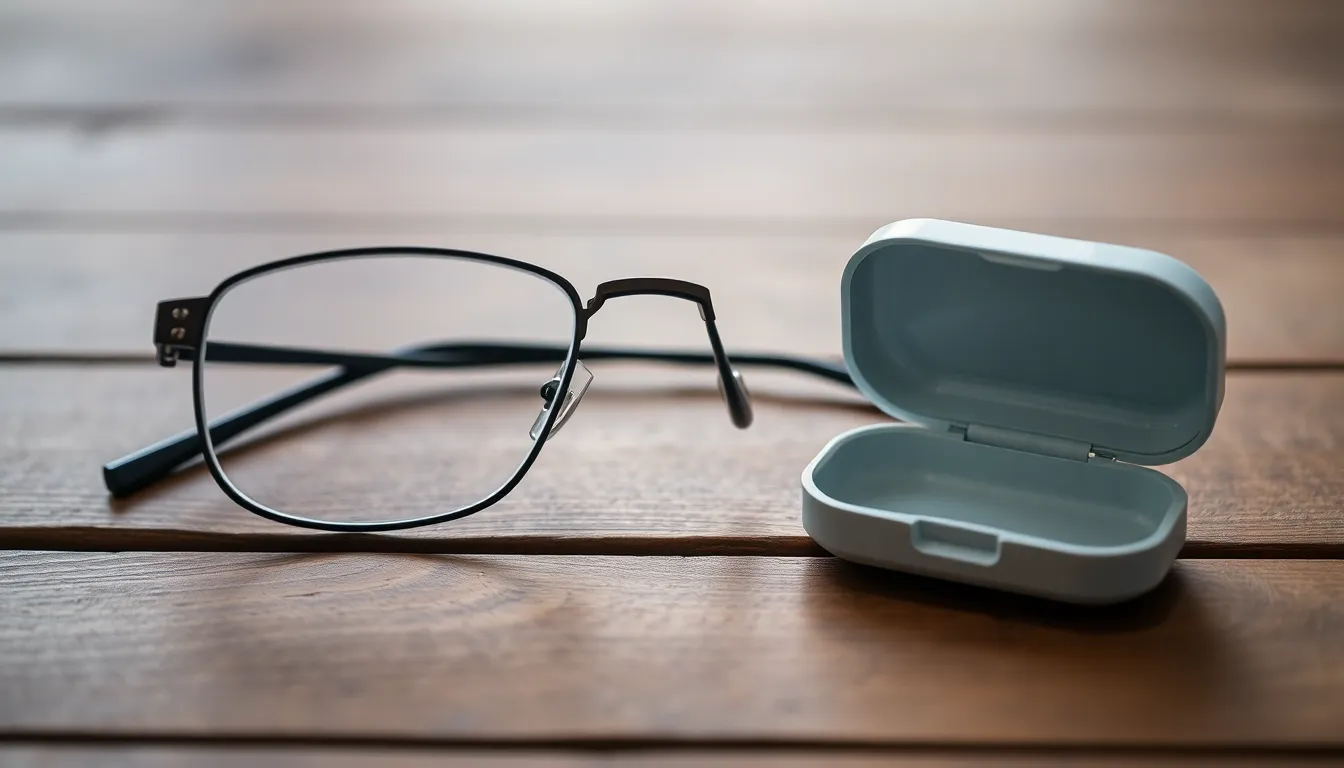When it comes to vision correction, many people find themselves caught in a frame of confusion. Are contact and glasses prescriptions really the same? Spoiler alert: they’re not! Picture this: you’re at the eye doctor, and after a few tests, you walk out with a prescription that looks like it belongs in a secret code. But hold on—what if you think you can just swap your glasses for contacts like trading snacks at lunch?
Table of Contents
ToggleUnderstanding Prescription Basics
Prescription details significantly influence vision correction methods. Glasses and contact lenses serve similar purposes but have unique prescriptions.
What Is a Glasses Prescription?
A glasses prescription includes information on lens strength, type, and eye measurements. Typically, it contains sph (sphere), cyl (cylinder), and axis values. Sph denotes nearsightedness or farsightedness, while cyl and axis indicate astigmatism. An average prescription might read -2.00 in sph and -1.00 in cyl with an axis of 180 degrees. These values ensure accurate lens curvature and thickness for optimal vision.
What Is a Contact Lens Prescription?
A contact lens prescription differs from a glasses prescription in several ways. This type includes all relevant measurements, such as base curve and diameter. Base curve affects lens fit on the eye’s surface, while diameter ensures lens stability and comfort. For instance, a typical contact lens prescription may have a base curve of 8.6 and a diameter of 14.2. Keeping these details in mind prevents discomfort and maintains visual clarity with contact lenses.
Key Differences Between Prescriptions

Understanding the differences between contact lens and glasses prescriptions is crucial for optimal eye care. They contain varying details that impact comfort and vision clarity.
Measurement Variations
Glasses prescriptions typically include values for sphere, cylinder, and axis. This setup addresses the lens thickness needed for glasses, which sit away from the eye. In contrast, contact prescriptions include these values plus additional measurements necessary for eye safety. Readers must note the difference in power between the two types. Contact lenses sit directly on the eye, demanding precise measurements to ensure a proper fit. Each prescription serves its own purpose and reflects unique measurements necessary for accurate vision correction.
Base Curve and Diameter
Base curve and diameter are essential components of contact lens prescriptions. Base curve defines the curvature of the lens, crucial for achieving a comfortable fit against the eye’s surface. Diameter indicates the width of the lens, directly affecting how it sits on the eye. These measurements ensure that contact lenses align perfectly with the curvature of the cornea. Glasses prescriptions lack these specific requirements, as glasses do not touch the eye in the same way. Contact lenses require detailed specifications to maintain comfort and prevent issues like dryness or irritation.
Why the Distinction Matters
Understanding the differences between contact lens and glasses prescriptions holds significant implications for effective vision correction. Each serves its own purpose, yet they are not interchangeable.
Comfort and Fit
Successful fit of lenses on the eye directly impacts comfort. Contact lenses sit on the eye’s surface, requiring precise measurements like base curve and diameter. These details ensure the lenses align with the curvature of the cornea. A proper fit helps eliminate discomfort, dryness, and the risk of irritation. Glasses, however, rest a distance away from the eyes, focusing on lens thickness and weight rather than direct contact. Patients often find contacts provide freedom and convenience, especially during physical activities or in different weather conditions.
Vision Correction Needs
Vision correction needs also differ considerably between contacts and glasses. Glasses prescriptions concentrate on distance vision with measurements for lens power, such as sphere, cylinder, and axis. Contacts require additional information for both clarity and comfort. They adjust directly to the surface of the eye, impacting how light enters. The need for precise fitting parameters means prescriptions must account for eye shape variations and individual preferences. Patients must rely on their eye care provider to prescribe the correct type to ensure optimal vision correction.
When to Consult Your Eye Care Professional
Understanding when to consult your eye care professional can significantly impact eye health and vision correction effectiveness. Regular check-ups help identify changes in vision and ensure proper lens fit and prescription accuracy.
Regular Eye Exams
Regular eye exams play a crucial role in maintaining optimal vision. They help detect eye conditions early and allow for timely intervention. An eye care professional can assess visual acuity and determine if prescription changes are necessary. During these exams, eye health is evaluated, encompassing checks for cataract, glaucoma, and other conditions. Scheduling exams every one to two years generally suffices, but individuals with existing conditions may require more frequent visits.
Updating Your Prescription
Updating your prescription ensures you receive the most effective vision correction. Vision can change over time due to various factors, including age and health conditions. Signs that indicate a need for an updated prescription may include difficulty focusing, eye strain, or headaches. Eye care professionals recommend periodic evaluations, especially if these issues arise. Trusting an expert to assess your needs guarantees an appropriate prescription, whether for glasses or contact lenses. Following their guidance leads to improved vision clarity and overall comfort.
Understanding the differences between contact and glasses prescriptions is essential for effective vision correction. Each type of prescription serves its unique purpose and requires specific measurements to ensure comfort and clarity.
Relying on an eye care professional for the correct prescription is crucial. They can provide tailored recommendations based on individual needs and changes in vision over time. Regular check-ups help maintain eye health and ensure that prescriptions remain accurate.
Choosing the right lenses can significantly impact daily life, making the distinction between contacts and glasses prescriptions a vital aspect of eye care.



